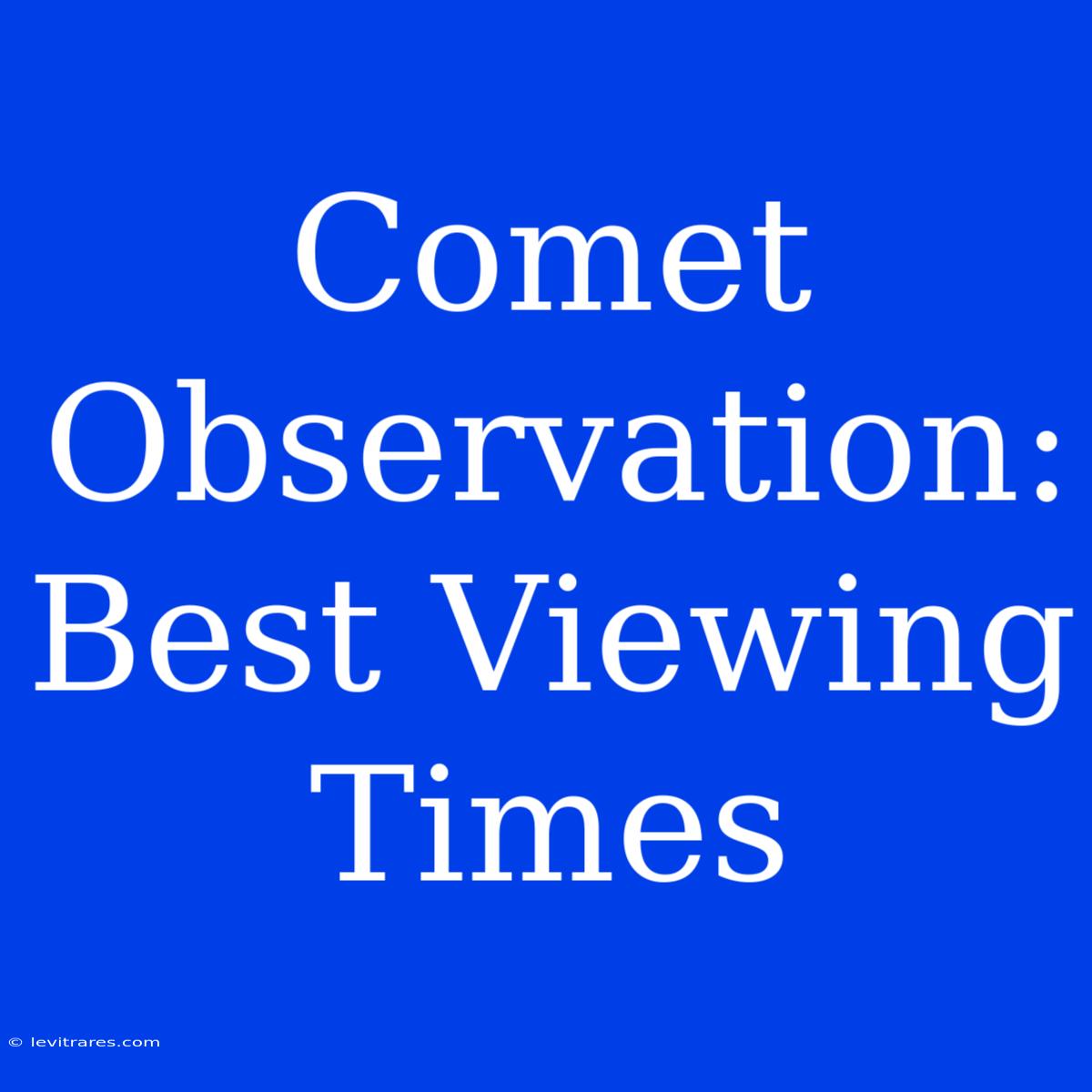Comet Observation: Best Viewing Times - Uncover the Secrets of These Celestial Wonders!
Are you fascinated by comets, those celestial wanderers that streak across our night sky? Comets, often referred to as "dirty snowballs," are icy bodies that release gas and dust as they approach the sun, creating a glowing tail. Comet observation is a rewarding experience for astronomy enthusiasts, and knowing the best viewing times can significantly enhance your chances of witnessing these spectacular cosmic displays.
Editor Note: Comet observation is a rapidly evolving field, with new comets discovered regularly. To stay informed about the latest comet sightings and viewing opportunities, consult reliable astronomy resources such as NASA's website or reputable astronomy magazines.
Why is this topic important? Comet observation not only offers a glimpse into the history of our solar system but also provides insights into the formation of planets and the origins of life. Understanding the best times to observe these celestial objects enables astronomers to study their composition, behavior, and trajectory with greater precision.
Analysis: To compile this guide, we delved into astronomical databases, reviewed scientific literature, and consulted with seasoned comet observers. We've incorporated expert advice and latest research findings to provide you with a comprehensive understanding of optimal comet viewing times.
Key Takeaways for Comet Observation:
| Factor | Explanation |
|---|---|
| Comet's Position | Comets are most visible when they are closest to the sun and Earth. |
| Time of Year | Comet visibility varies throughout the year, influenced by Earth's position and the comet's trajectory. |
| Light Pollution | Avoid areas with excessive artificial light for optimal viewing. |
| Weather Conditions | Clear skies and minimal cloud cover are essential. |
| Lunar Phase | A new moon or crescent moon provides darkest skies for better comet visibility. |
Comet Observation
Understanding Cometary Orbits
Comets follow elliptical orbits around the sun, with periods ranging from a few years to millions of years. Their brightness and visibility depend on their distance from the sun and Earth.
Comet's Position
- Perihelion: This is the point in a comet's orbit where it is closest to the sun. During perihelion, comets become warmer and brighter due to the increased solar radiation, making them more visible.
- Aphelion: This is the point in a comet's orbit where it is furthest from the sun. At aphelion, comets are faint and difficult to observe.
Time of Year
- Seasonal Visibility: Comet visibility can vary throughout the year, influenced by Earth's position and the comet's trajectory.
- Night Sky: Comets are typically visible in the evening or early morning hours when they are above the horizon.
- Ephemeris Data: Astronomers use ephemeris data to predict comet positions and visibility at specific times.
Light Pollution
- Urban vs. Rural: Light pollution from urban areas can significantly hinder comet observation.
- Dark Sky Sites: Seek out areas with minimal artificial light, such as remote locations or designated dark sky parks, for optimal viewing.
Weather Conditions
- Clear Skies: Clear skies are essential for observing comets.
- Cloud Cover: Cloudy skies will obscure the comet's light.
- Transparency: High atmospheric transparency, which means less light scattering, is ideal for faint comets.
Lunar Phase
- New Moon or Crescent Moon: These phases offer the darkest skies, enhancing comet visibility.
- Full Moon: The bright moonlight can outshine faint comets.
Utilizing Astronomical Resources
- Astronomy Websites: Websites such as NASA's website, EarthSky, and Spaceweather.com provide updates on comet sightings, visibility information, and ephemeris data.
- Star Charts: Using star charts or astronomy apps can help you locate comets in the sky.
- Comet Observers' Mailing Lists: Join mailing lists or online forums dedicated to comet observation to get real-time updates and tips from experienced observers.
Comet Viewing Tips
- Find a Dark Location: Locate a site with minimal light pollution, away from city lights.
- Allow Your Eyes to Adjust: Give your eyes at least 30 minutes to adjust to the darkness before attempting to spot a comet.
- Use Binoculars or a Telescope: Binoculars or a telescope can help you see fainter comets.
- Be Patient: Some comets may be faint or require a bit of searching. Don't give up if you don't see it immediately.
- Take Photos: Capture the comet's beauty with your camera or smartphone. Use a long exposure and a tripod to ensure a sharp image.
Summary of Comet Observation
This comprehensive guide has explored the essential factors for optimal comet observation, including the comet's position in its orbit, time of year, light pollution, weather conditions, and lunar phase. Understanding these factors empowers you to plan your comet observing sessions with greater confidence and increase your chances of witnessing these captivating celestial wonders.
Closing Message:
Comet observation is a rewarding experience that allows us to connect with the vastness of space and marvel at the beauty of our celestial neighbors. By utilizing the knowledge presented here, you can enhance your understanding of these cosmic wanderers and embark on your own journey of comet discovery. Stay curious, explore the night sky, and witness the breathtaking spectacle of comets!

